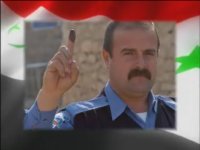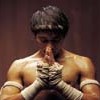Agam's Gecko


Tuesday, March 25, 2008
TIBETAN PROTEST CONTINUES; CHINA'S DECEPTIONS, KILLINGS ALSO CONTINUE
| T |
ibetans have continued protesting, and getting killed for it by Chinese forces, in eastern Amdo and Kham regions of the country. On Monday afternoon March 24, monks were joined by nuns in Drawo Township in Drango County, Kham region, Kardze "TAP" (Ch: Sichuan province) and launched a protest march to the township government offices, as common citizens also joined in. They chanted freedom slogans and "Long Live Dalai Lama!"
One person was killed and at least one other was critically wounded.
According to multiple sources within Tibet, when the protesters were marching towards the township headquarters, a large number of People's Armed Police (PAP) and Public Security Bureau (PSB) officers came to the scene to quell the agitated protestors. In the process, a clash occurred between the two sides, soon the Chinese security forces started firing live ammunitions indiscriminately into the protesting crowd, which led to the dead of at least one monk and left another in critical condition. The dead Tibetan is identified as Kunga, a 18-year-old monk of Chokri Monastery, Drango County (Ch: Luhuo xian), Kardze, "TAP". Tsewang Dhondup, 30-year-old monk from the same monastery is known to be in critical condition after being shot by Chinese security forces. According to sources within Tibet, many doubt if he could survive the gun shot injury. No further information on the exact number of dead, injured or arrest could be ascertained at the moment.A week earlier, a similar protest in the same area resulted in at least three Tibetans shot dead and 15 injured from indiscriminate firing.
On Saturday the 22nd, several hundred Tibetans in Chentsa County, Amdo region, Malho "TAP" (Ch: Qinghai province) carried out a religious ceremony which turned into a peaceful procession to the county headquarters. They chanted freedom slogans, carrying portraits of Dalai Lama and the (kidnapped by Chinese government) eleventh Panchen Lama, and raised the Tibetan National flag. Prominent religious leaders avoided bloodshed by persuading the demonstrators to turn back and return to their homes. Hundreds of Chinese forces in full battle gear had been awaiting their arrival.
On the following day around 800 Tibetans from four villages in another part of Chentsa County mounted another procession, but were intercepted and turned back by Chinese forces without reported casualties. Chentsa County was undergoing a massive influx of troops sent from the Chinese city Xining at the time of these reports.
The photos above were taken on March 17 in Chigdril County, Amdo, and were sent to Tibetan Centre for Human Rights and Democracy, where you can view more of them in larger format. What we see in these photos is the standard non-violent demonstrations which have swept across eastern Tibet without any let up for two weeks. These are the same type of activities which have prompted Chinese forces to shoot schoolchildren dead.
The Tibetan Government in exile has more details on these and other demonstrations over recent days, as well as the names of some of those detained. As well as this item from Machu County -- to go into our Chinese deceptions file:
On March 22, 2008, around 1PM local time, military dressed in monk robes severely beat 8 laypersons and arrested them too.The exile government has updated its death toll to 140 as of yesterday, and have included a partial name list of 40 who have been identified. Due to restrictions imposed by the Chinese government, identifications are difficult.
Many of the dead bodies from the recent demonstrations are being turned into the People's Procuratorates instead of being returned to their respective families. This has also made it more difficult to gather details on the death toll.The Chinese government says no Tibetans have been killed, four were wounded, and all the dead have been Lhasa Chinese. Liars.
Now for something else for that deceptions file. In an article last Saturday I referred to a piece written by an international security analyst who claims that a British monitoring agency have evidence for Chinese manipulation and agents provocateurs involved in the Lhasa riots. The Tibetan government said it could confirm that personnel from at least four Chinese military units have been dressing up as monks (for various purposes).
There is now more evidence of this type of dirty tricks. A witness from Thailand who had been in Lhasa on March 14, recognized one of the pictured "rioters" as a policeman of her own acquaintance. Phayul has the story.
A Chinese woman from Thailand (who prefers that her name not be used) was studying in Lhasa when the protests broke out in March. As one of her friends is a policeman, she visited him at the local police office quite often and got to know other policemen there.Why am I not surprised? The Thai witness was shocked, and realised that the man with the knife was a police agent provocateur. She contacted an India-based Tibetan organisation and told them what she'd seen. The organisation publicized the news photo at a rally in India, identifying him as a policeman.
After the protests on March 14, she and other foreigners were sent to the police office where she saw a man with a knife in his hand walking in with some arrested Tibetans. The man later took off the Tibetan-style clothes and put on a police uniform.
This woman was sent out of Lhasa with other foreigners the next day. When she arrived in India via Nepal, she recognized the policeman she had seen in Tibetan garb from BBC TV news and photos that the Chinese embassy had provided to the media.
The Chinese embassy provided two batches of photos to the media, one issued before that rally and one afterwards. In the batch issued after that rally, the policeman in disguise had disappeared from photos taken at the same scene in which he had previously been visible.So. The Chinese secret police can play with PhotoShop too, can they?
Ngawang Nyendra said, "This photo with this man in it was sent by the Chinese embassy to BBC and Radio Free Asia. The other photo was sent out later. They are exactly the same except the man has disappeared from the second photo.
"From the TV news footage, you can see this man attempting to stab other people with a knife. But in later shots you can't find this person any more. They were acting. After people raised questions about these shots, this footage never appeared on TV again."
Apparently this is just traditional CCP tactics. After the 1989 uprising in Lhasa, a Chinese journalist documented similar methods used at that time.
According to the book, a few days after the Tibetans' peaceful protest, the CCP authorities sent out many special agents and plainclothes police disguised as civilians and monks to create a scene of rioting. They burnt sutra pagodas, broke into and robbed grain stores and other stores, and inspired other people to loot. After that, the army and police started a bloody crackdown.A digression: This is a page from Suharto's book. Or maybe Suharto took a page from the CCP book. The riots which burned for three days in Jakarta in May 1998 were instigated by mysterious gangs of men travelling around in trucks. They would get some looting going on in one area, and then move on to another part of the city and do it again. No one ever recognised them as local people, and they all had military-style haircuts and wore military boots. The majority of the approximately 1,500 deaths during the three days were poor slum-dwellers who were taking goods out of stores after these truck-borne gangs opened them up and got things going. Fires were set in these large department stores when they were full of these people, who lived in the shanties surrounding them.
Those events were also described as "anti-Chinese riots." The stores were all Chinese-owned. End of digression.
If the Chinese people ever learn the extent that their government has been lying to them, deviously scheming to finish their "Tibet problem" in any way other than with honesty and genuine good will, the people may well turn on them with a vengeance.
Here is a very good story I wanted to pass along, by AP writer Cara Anna, about the Tibetan community of Chengdu City: Far from Tibet, a neighborhood is silent.
In the spirit of the open letter from Chinese intellectuals at the weekend, the most senior official jailed over the 1989 pro-democracy protests in Beijing, Bao Tong, sent a statement to Reuters yesterday. The former top aide to former Party Secretary Zhao Ziyang, who was ousted for opposing the military crackdown on the Tiananmen students, frequently writes critical open letters to the party leadership -- especially at National People's Congress time. He urged his government to sit down with Dalai Lama for some honest discussions for a change.
"So long as the central (government) sits down for dialogue with the Dalai Lama and shows great wisdom, great decisiveness and great boldness of vision, the Lhasa incident can be handled well," Bao wrote in a statement e-mailed to Reuters on Monday.Bao Tong lives under house arrest in Beijing.
[...]
Bao, who was jailed for seven years and is now an outspoken critic of the government, said many Westerners refused to believe China because it had a "history and tradition of irresponsibly and arbitrarily meting out verdicts on major cases".
He spoke of the Chinese leadership's "hastiness, subjective assertions and leaving mistakes uncorrected" in 1989.











 Our way of saying "thanks" in the Thai way. Here a nak muay Thai (kickboxer) offers respect and thanks for his teacher (wai khru) before a match. This is our local variation on the ubiquitous "hat tip" used in general blog culture.
Our way of saying "thanks" in the Thai way. Here a nak muay Thai (kickboxer) offers respect and thanks for his teacher (wai khru) before a match. This is our local variation on the ubiquitous "hat tip" used in general blog culture.





